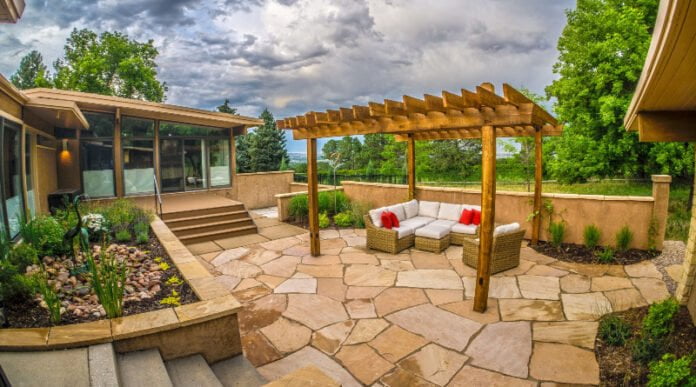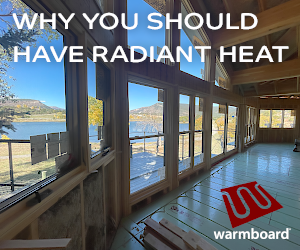Whether they live in downtown Denver or on a remote mountain lot, Colorado homeowners want areas where they can be outside. A peaceful outdoor retreat might entail a simple flagstone patio with a fire pit or an elaborate outdoor kitchen and fireplace.
For contractors in Colorado, one thing they have to consider when designing an outdoor living area for their clients is the impact that snow and freezing temperatures will have on it.
A place to gather
Fire pits and fireplaces are a focal point around which a design can be built, but for Colorado homeowners, they’re one of the most important elements allowing them to use their space year-round.
There are several things to consider when choosing a fire pit or fireplace.
One of the most easily overlooked considerations requires builders to get to know the homeowner and understand how they will use the space. Homeowners who like to entertain may prefer a fire pit to a fireplace.
“Most of our projects have fire pits because they allow a larger group to sit around and utilize the space,” Paul Fredell, owner of Fredell Enterprises in Colorado Springs, said. “What we see more often than not is that the older folks or the women tend to sit closer to the fire, looking for a little more heat, and the guys tend to sit a little farther from the fire normally.”
RELATED: Form and Function Key to Fire Pit Selection
Some fire pits are also mobile, allowing the homeowner to move it to accommodate a larger group or wind direction.
“With the winds we get in Colorado, there’s a downdraft problem on the fireplaces,” he said. “That can be an issue because you don’t have four walls surrounding you. … Depending on the direction of the wind, your fireplace may or may not be usable, whereas the fire pit you can move.”
Jake Harris, owner of Colorado Springs-based Jake’s Designs, pointed out that builders need to make sure their clients have the right infrastructure in place for their fire pits.
“Especially on these new houses, they’ll say, ‘Oh, we’ve got a gas line already plumbed out right here,’ and it’s this little half-inch thing that maybe creates 60,000 to 80,000 BTUs, which is great for a grill, but will not do a doggone thing for a fire pit,” Harris said.
Harris said he uses fire pits that put out a minimum of 120,000 BTUs, and he has used elements that go up to 250,000 BTUs.
“That’s a good way to keep everything warm out there in the wintertime when people are sitting around that fire pit,” he said.
All about that base
The Colorado climate means some trends won’t have the longevity clients want in a design. Stamped concrete, for example, isn’t a good choice.
“There are two types of concrete in Colorado: new and cracked,” Harris likes to tell customers. “In our arid climate, with a rigid, brittle substance such as concrete, it doesn’t really mix well with our freeze-thaw cycles.”
Harris opts for pavers and flagstone instead, but the most critical aspect when it comes to hardscape longevity is getting the base right.
“If the base is not right, then nothing on top is going to be right,” he said. Harris uses “eight inches of road base, laying a thin layer of sand on top of that and getting all of our pavers and our flagstone installed correctly.”
Fredell also uses pavers more than other hardscape materials due to “the soils and such that we have here, and the fact that compaction sometimes, especially right up around a new home, is an unknown factor because of the excavation that went on during construction.”
“The paver allows for some movement, is easily repaired if necessary, and we don’t end up with cracking and stuff,” Fredell said.
They’re also not as slick as stamped concrete when it’s wet or icy outside, he noted.
Ice, ice, maybe
Water elements and lighting are simple ways to create high-impact designs. While water features are popular tools to create tranquil outdoor areas, they usually require some level of winterizing.
“Water features can run year-round as long as you’re running about 6,000 gallons per hour or above through them,” Harris pointed out. Smaller elements like bubbling boulders use a fraction of that water load, so homeowners will have to remove pumps before the first freeze and store them in water in their homes so the seals remain pliable for the next season, he said.
Larger elements like streams or ponds aren’t as susceptible to freezing, but floating heaters or aerators help prevent ice forming.
The options for lighting a landscape and outdoor living area are extensive, so Fredell reminds his clients that “we’re not here to look at the fixture, we’re here to look at the effects of the light.”
Although elaborate lighting systems with multiple color options are popular, Fredell noted that homeowners tend to leave lights in the warm end of the color spectrum.
“It’s the occasional party, and a theme for a party, that is when the colored lighting becomes a lot of fun. A Broncos party obviously comes to mind or a birthday party,” he suggested.
A site for sore eyes
Color and texture are important elements in creating inviting spaces for homeowners. Fredell believes one way that designers hurt themselves is by trying to incorporate too many elements.
“For instance, in the hardscape, where you see stone and tile and stucco and all these things, there are way too many items that conflict,” he said. “Keeping the design and the number of materials to three or four, and using them in the appropriate manner, is certainly very important.”
Harris uses a home’s siding as a starting point when thinking about how to use color and texture in a design.
“A lot of these new houses that are being built nowadays have a lot of stone veneer accents,” he said. “We will source that same stone veneer … so we can get some correlation between their house and some of the elements that we’re installing out in the landscape.”
Thoughtful design also helps ensure interesting elements last all year, even after the growing season. Harris makes plant selections based on when they flower.
“The first things that are coming out are the columbine and the lupine, and then, later on in the summer, we’re getting some of the yarrow,” he said. Ornamental grasses and red-twig dogwood add visual interest when other plants aren’t blooming.
“We’re looking at winter texture here probably five to six months out of the year,” he pointed out.
Peace and quiet
“Every great design starts out with a great site analysis,” Harris said. Understanding how a home and patio will be impacted by sun and wind exposure as the seasons change helps builders and designers plan for a homeowner’s changing needs throughout the year.
For example, Harris and his team rely on deciduous trees in passive solar concepts.
“We’ll plant a deciduous tree on the southern exposure of a patio so during the summertime, when it’s hot out there, that deciduous tree will have all of its leaves on it and it will provide shade to that patio; then in the wintertime, when that tree loses all of its leaves, the sun will be able to penetrate through the branches and will make that more of a sunny patio,” he explained.
RELATED: Great, Wide, Open: Bringing the Great Outdoors to Homeowners’ Doorsteps
Fredell noted that glass partitions can prevent a space from feeling too closed in, but they have to be cleaned often. When he has to use screens for separation from nearby neighbors, he prefers lattice or architectural screens.
Using plantings to protect outdoor areas from the elements is a natural choice for Fredell.
“One of the reasons that we are building outdoor living spaces [is] not to have walls. [If] we want to be surrounded by walls, we can go inside,” he said.







